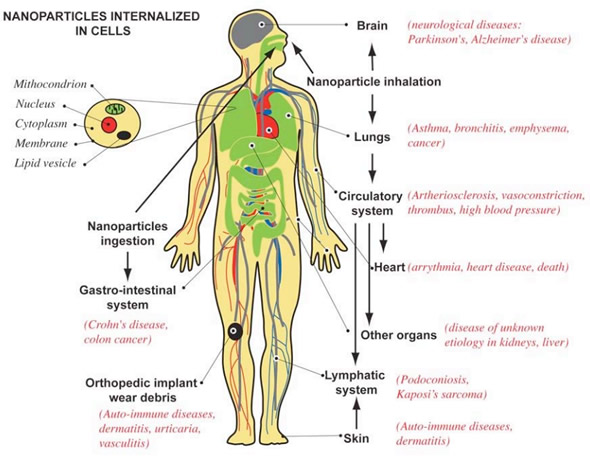Safety of Nanoparticles
Current research indicates that exposure via inhalation and skin contact can result in nanoparticles entering the body. Nanoparticles are tiny particles that can be inhaled or ingested and may pose a possible problem both medically and environmentally.
Why are nanoparticles considered dangerous ?
The safety issues with nanoparticles are not very well known but their potential for danger is evident due to the high surface area to volume ratio, which can make the particles very reactive or catalytic. In addition, these are able to pass through cell membranes in organisms and may interact with biological systems.

Natural nanoparticles and possible safety concerns
Nanoparticles in nature that occur in free form quickly tend to agglomerate and thus leave their nano-forms and stop being a danger to organisms. Animal studies have shown that some nanoparticles can penetrate cells and tissues. These may move through the body, reach vital organs like brain and cause biochemical damage and even cancer.
In addition, nature itself presents many nanoparticles to which organisms on earth may have evolved immunity. For example, salt particulates from ocean aerosols, terpenes from plants etc.
Risk for nanomaterials in use
Nanoparticles in cosmetics and sunscreens pose health risks that are largely unknown and need further studies to explore their harmful effects over long term.
How do nanoparticles enter the body?
Human and animal studies show that inhaled nanoparticles can deposit in the respiratory tract. Animal studies also show nano particles can enter the bloodstream and translocate to other organs.
These particles may be individual particles, agglomerates of nano particles, and particles from nanostructured materials that become airborne or come into contact with the skin.
Occupational hazards with nanoparticles
Some workplaces raise the risk of exposure to Nanoparticles. These include:
- Workers who deal with nano particles in liquid media without adequate protection (e.g., gloves) will increase the risk of skin exposure. Exposure can occur during pouring or mixing operations, or where a high degree of agitation is involved. Agitation may also lead to inhaled intake of the particles.
- Those who handle nano structured powders run the risk of aerosolization.
- Those who clean dust collection systems used to capture nano particles are at risk of both skin and inhalation exposure
Prevention of nanoparticle exposure
Although the health risks of Nanoparticles are not clearly defined, the work practice and engineering control procedures to prevent exposure are well understood. Most measures adopted are similar to standard laboratory practices regarding the use of hazardous chemicals and gases.
In addition, other precautions include:
- Lab protection and hygiene – regularly laundered lab coats must be worn. Lab coats may not be taken to private homes and laundered. Arm sleeves are required where high levels of exposure or splashes of solutions containing nano particles are anticipated.
- Hand washing facilities must be provided in all labs. Hand washing must be performed after handling nano materials.
- Standard Penn safety glasses are required when working in any lab.
- Gloves (disposable nitrile) must be worn when handling nano materials.
- Clothing should include long pants and closed toed shoes
- Respirators and ventilators are needed to prevent inhalation
- Dry nanomaterials should be handled only within fume hood, biological safety cabinet, glove box or a vented filtered enclosure.
- Dry nanomaterials need to be transferred in closed containers
- Nanoparticle solutions need to be handled over disposable bench covers
- Aerosol producing activities (such as sonication, vortexing and centrifuging) may not be conducted on the open bench. These can be performed in fume hood, biological safety cabinet, glove box or a vented filtered enclosure.
- Spills of dry nano particles must be cleaned with a HEPA vacuum. Dry sweeping must not be used. Large spills must be cleaned by EHRS.
- Lab pressurization must be negative to the hallway. Ventilation should be adequately managed.
- All solutions and solid materials must be disposed of as hazardous waste following established University guidelines.
Sources
- www.ehrs.upenn.edu/media_files/docs/pdf/chp_sop_nanoparticles.pdf
- http://www.hse.gov.uk/research/rrpdf/rr274.pdf
- http://www.purdue.edu/rem/home/booklets/nanopolicy.pdf
- http://ice.chem.wisc.edu/NanoDecisions/PDF/RiskAndSafety.pdf
- http://arxiv.org/ftp/arxiv/papers/0801/0801.3280.pdf
Further Reading
- All Nanoparticle Content
- Nanoparticles – What are Nanoparticles?
- Nanoparticle Uniformity
- Properties of Nanoparticles
- Synthesis of Nanoparticles
Last Updated: Apr 3, 2019

Written by
Dr. Ananya Mandal
Dr. Ananya Mandal is a doctor by profession, lecturer by vocation and a medical writer by passion. She specialized in Clinical Pharmacology after her bachelor's (MBBS). For her, health communication is not just writing complicated reviews for professionals but making medical knowledge understandable and available to the general public as well.
Source: Read Full Article
